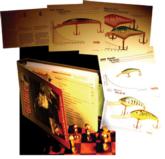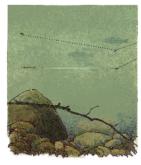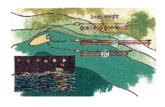Board games
Mark Brumbaugh uses planer boards as tactical maneuvers to score big walleyes
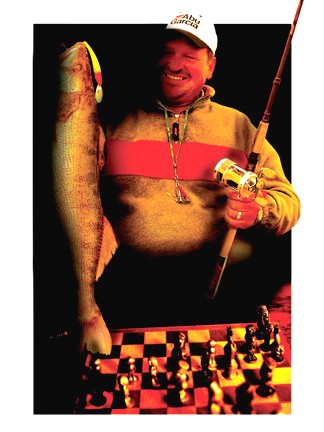
Plus related article: ‘In-line boards & lead core’
Mark Brumbaugh, a soft-spoken farmer from Arcanum, Ohio, never met a walleye tactic he did not like. He excels at everything from casting 1/16-ounce jigs to trolling deep-diving crankbaits. His diverse skills have helped him pocket more than a quarter of a million dollars while competing in walleye wars over the past 13 years.
Bright yellow Off Shore Side Planer Boards have accounted for a substantial share of Brumbaugh’s winnings. He begins trolling the in-line boards soon after ice-out and keeps them wet until winter halts his fishing. Whether walleyes suspend, hug deep structure or feed in the shallows, Brumbaugh’s boards drag crankbaits and spinner rigs past their noses.
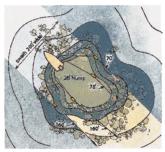 While plodding along at trolling speed, Brumbaugh drops a lure back the desired distance from his boat and clips a board to his line. When he drops the board in the water, its beveled nose pulls it out as far as 100 feet from the boat. With two boards out on each side of the boat, Brumbaugh trolls a swath 200 feet wide.
While plodding along at trolling speed, Brumbaugh drops a lure back the desired distance from his boat and clips a board to his line. When he drops the board in the water, its beveled nose pulls it out as far as 100 feet from the boat. With two boards out on each side of the boat, Brumbaugh trolls a swath 200 feet wide.
In-line boards prevent Brumbaugh’s boat from spooking walleyes. When the boards bounce on rough water, they impart a lively action to his baits. This deadly combination gave Brumbaugh a big opening-round catch during an October tournament on Green Bay.
The fish were clustered over a 28-foot-deep hump located 70 miles from the weigh-in site. Brumbaugh got his baits down to the structure by dropping deep-diving Reef Runners 160 feet behind two of his in-line boards. His other two boards pulled spinner rigs with 2-ounce Snap Weights 70 feet behind the boat.
Brumbaugh’s five-fish limit on the first competition day weighed 30 pounds, 15 ounces. He felt confident until he looked out on Green Bay the next morning and saw huge waves crashing against the shoreline. The remainder of the event was limited to the Fox River. Though Brumbaugh never returned to his hot hump, his initial catch with in-line boards helped him nail down seventh place.
“I troll a lot of free-running crankbaits behind boards,” Brumbaugh said. “Today’s baits cover depths ranging from 2 to more than 40 feet.”
The “Precision Trolling” guide by Dr. Steven Holt, Mark Romanack and Tom Irwin provides Brumbaugh with a reliable reference to the diving depths of many popular crankbaits. Brumbaugh always has a copy of this guide aboard his 620 Ranger. He warns against getting stuck on any particular setup.
“Lazy walleye fishermen keep dragging the same baits at the same settings and wonder why they strike out,” Brumbaugh said. “If you’re not catching fish, keep changing the speed, the depth and the baits until you begin connecting. If a bait isn’t doing the job 120 feet behind a board, I may put it back to 200 feet. If that draws a blank, I’ll shorten the distance to 80 feet.”
Spinner rigs, which dupe walleyes for Brumbaugh throughout the year, always require some type of weight to pull them down. Brumbaugh also runs weights with crankbaits that do not run deep enough. For example, cold-water walleyes often prefer the subdued wobble of a shallow-running minnow, or walleyes may key on little baitfish and demand a small crankbait as opposed to deep divers, which usually feature large bills and bodies.
“The easiest way to get baits deeper is by pinching a 1/2- to 3-ounce Snap Weight to the line,” Brumbaugh said. “I especially like Snap Weights when I troll for suspended fish because I don’t have to worry about the weight snagging bottom.”
To simplify his trolling, Brumbaugh often relies on the basic 50/50 program. The 50/50 reduces the settings you must remember. Simply let the lure out 50 feet behind a moving boat and fix a Snap Weight to the line. Then let out another 50 feet of line and attach the board.
The only variables with the 50/50 are the lures being used and the speed of the troll. Trolling speed is especially critical. Even a slight change in speed dramatically alters the depth when a Snap Weight is placed on the line. Slower speeds allow the weight to sink deeper and vice versa. This is why precise depth control is more difficult to achieve when trolling with weights.
Even so, Brumbaugh knows that it usually is not crucial to determine exactly how deep a given lure is running. As long as he can duplicate a setup and the trolling speed that catches a walleye, he can put the bait right back in the strike zone.
Though Brumbaugh gives the 50/50 high praise, he does not hesitate to experiment with line lengths if he believes a change in presentation is necessary. If you do not have Brumbaugh’s mind for remembering a variety of settings, bring a pad and pencil and take notes when you experiment with line lengths.
“If I want a crankbait to run deeper, I increase the lead from the bait to the weight,” Brumbaugh said. “I shorten the lead if I want a crankbait to run shallower.”
To give a spinner rig a jerky action when trolling on rough water, Brumbaugh clips a 2- or 3-ounce Snap Weight only 5 to 10 feet behind the board. A longer line softens the impact of the dancing board and reduces the spinner rig’s dart-and-pause action.
Brumbaugh trolls his Ranger with the same confident hand that guides his tractor when he plows neat corn rows on his Ohio farm. In early spring, when sluggish, cold-water walleyes demand speeds as slow as 0.75 mph, Brumbaugh runs spinners and subtle long-minnow baits behind his boards. He dotes on Reef Runner’s Ripstick.
When walleyes grow more active in the summer, Brumbaugh jumps his trolling speed to 2.5 to 3 mph and switches to what he calls “searching” crankbaits.
“When the water gets hot in the summertime, walleyes like crankbaits that swim with a really wide, erratic action,” Brumbaugh said. “Hot ‘N Tots and Wiggle Warts are good bets then.”
When he trolls open water for suspended walleyes, Brumbaugh goes with 10-pound Berkley XT. After extensive testing, he is convinced that the stretch of monofilament brings about a better strike-to-catch ratio.
Brumbaugh prefers Berkley FireLine when walleyes hold tight to the bottom. Because 14-pound FireLine has the diameter of 6-pound monofilament, it often allows crankbaits to dive deep enough on a free line to eliminate the need for a weight.
Shallow water poses no problem for Brumbaugh and his in-line boards. When walleyes feed over submerged weeds or a shallow flat or close to a shoreline, he sweeps his boards over the fish by trolling parallel to the shallows in adjacent deeper water.
When trolling spinners, he places a few split shots or a small Snap Weight 10 feet in front of the lure and connects the board 10 feet up the line from the weight. He drags shallow-minnow crankbaits, another excellent option, 20 to 30 feet behind his boards with no weight on the line.
